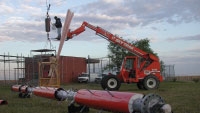Feedback
Look out below

Dear editor:
I noticed the opening photo for “The DTV dance” article on page S3 of the “Competitive Television Summit” supplement in your February issue. Do you see anything wrong with this picture … as in unsafe work practices?
I hate to say it, but I've worked with many tower crews over the past 35 years. Some are very safety conscious; others are not.
Dick Sigurdson
KMSP-WFTC Fox/UTV Holdings
Eden Prairie, MN
Brad Dick responds:
Yep, we sure did notice it. But, we only print the photos. It takes wiser readers, like yourself, to realize there are people who don't sufficiently value their own safety.
If you want to see safety violations, check out the new series “Ax Men” on the History Channel.
Get the TV Tech Newsletter
The professional video industry's #1 source for news, trends and product and tech information. Sign up below.
Tools of the trade
Dear Anthony Gargano:
I teach a two-year career and technical class on interactive media at a high school near Akron, OH. Thanks for your article “Advantageous resources” in the January issue of Broadcast Engineering.
Because I'm not in the production environment, it's tough to keep up with the many changes in media. You saved me a lot of time digging for resources. Some parts of these white papers are a little beyond my technical understanding, but I can glean enough to help keep students stay on top of developments.
Rich Barnett
Must reads
Dear editor:
I teach broadcast engineering at Hocking College in Nelsonville, OH. I was wondering if you can recommend a good entry-level textbook to use with freshman college students to teach digital high-definition engineering and the transition from analog to digital.
Harry L. Tompkins
Brad Dick responds:
Here are some good reference books. While none address just HDTV, remember that HD is just a subset of digital television.
- “Digital Television Fundamentals” by Michael Robin and Michael Poulin is a great book that focuses on theory of DTV/coding/video. It's the best reference for theory I know.
- “The MPEG Handbook” by John Watkinson is a good MPEG tutorial.
- “A Practical Guide to Audio and Video Compression” by Cliff Wootton is an excellent tutorial on compression, artifacts and encoders. It contains lots of images and examples.
- “Video Systems in an IT Environment” by Al Kovalick covers storage/IT/video and IT issues. It's very easy to read.
- “Video Demystified” by Jack Keith is a good video production/MPEG encoding tutorial. It has lots of color image examples.
- “DTV Survival Guide” by Jim Boston is a great over-the-air broadcast engineer tutorial, especially on RF.
- “A Broadcast Engineering Tutorial for Non-Engineers” by Graham Jones is mentioned on the NAB Web site. The Web site says: This new edition of “A Broadcast Engineering Tutorial for Non-Engineers,” “the bible” for new hires and others in the field, builds on what worked in the previous edition while adding new standards and defining the emerging digital technologies that are revolutionizing the field. This book is a must have for anyone that has any contact with the field of broadcast engineering.
Let me know if I can help further.
Test Your Knowledge!
See the Freezeframe question of the month on page 6.
